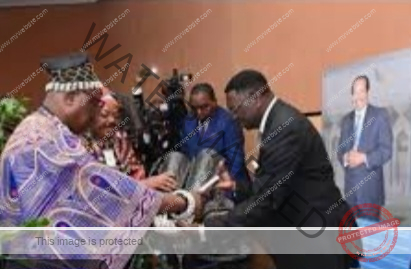In today’s Cameroon, the living leader is absent, the absent leader is everywhere, and the portrait of the absent leader rules more firmly than the man himself ever did.
By Wepngong Moses
The presidency has become a shrine.
No longer do citizens make pilgrimages to Jerusalem or Mecca; in Cameroon, the sacred destination is Etoudi. The faithful don’t carry rosaries or Qur’ans, but brown envelopes filled with pledges and pockets emptied of “contributions” — 5,000 to 10,000 CFA at a time.
At the centre of this shrine stands Ferdinand Ngoh Ngoh, the Secretary-General at the Presidency, acting like a high priest. He receives delegations on behalf of the invisible God-King, the one whose face appears everywhere yet whose physical presence is too holy for mortal eyes.
And here lies the paradox: to meet the Head of State, one must never see the Head of State. His image, not his person, absorbs the devotion. Portraits hang like sacred icons on every wall. Delegations kneel before them, swear allegiance to them, even grovel under their gaze. Some go further still, dragging along life-size statues, as if Israel’s golden calf had been reborn in Yaoundé.
Paul Biya is no longer treated as a president. He has been elevated into something untouchable — the Fon of Fons, the deity of marble, ink, and framed photographs.
The spectacle borders on the absurd. Chiefs who once commanded warriors now shuffle in as errand boys. Student leaders and professors, who should be custodians of truth and knowledge, degrade themselves by proving loyalty to a portrait. Even women are drafted in, not to advance gender equality, but to chant in chorus before the frame, turning equality itself into a prop for idolatry.
And for this pilgrimage, each delegate pays an offering: 2,000 CFA per head. It is like the indulgences of medieval Europe — but here the price is not salvation, only a chance for a photo-op under a portrait.
The hypocrisy is staggering. A regime so fragile it hides behind paper and plastic, yet demands the nation believe the ghost still breathes, rules, and reigns. Citizens are told: “Do not look for the man, only believe in the image.” Politics has become a cargo cult, where signatures and portraits carry more power than the person behind them.
So why travel all the way from Bamenda, Garoua, or Bertoua to Yaoundé, only to bow before a picture? Millions of identical copies already line the streets and offices. Would it not be simpler — and cheaper — for the High Priest to tell the faithful to kneel before the nearest portrait in their district, like congregations worshipping at local altars?
In today’s Cameroon, the living leader is absent, the absent leader is everywhere, and the portrait of the absent leader rules more firmly than the man himself ever did.
Wepngong Moses

